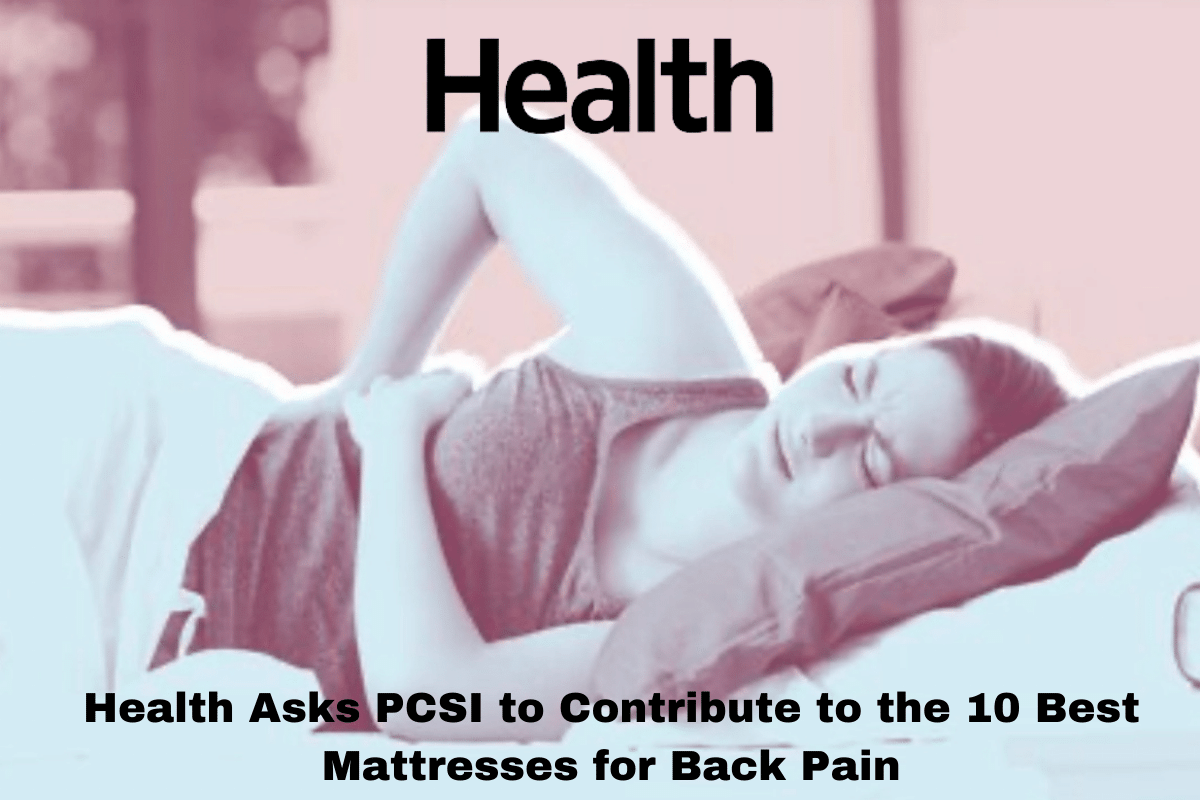
09 Feb Health asks PCSI for their input on choosing a mattress for back pain
The 10 Best Mattresses for Back Pain
If you or someone close to you is experiencing back pain, you’re not alone. Back pain is so common that the National Institute of Health estimates 80% of adults in the United States suffer from either acute or chronic back pain. While this pain can be caused by a number of variables, your mattress is a fundamental one—it can cause back pain or make it worse if you’re not sleeping on the right mattress.
To find that ideal fit, the primary areas to assess are firmness, sleep position, and mattress type and materials. It’s also crucial to know how your bed affects spinal alignment and supports pressure relief. In this guide, we’ve selected five of the best mattresses for back pain based on customer reviews and extensive testing.
These are the 10 best mattresses for back pain.
- Best Value: Nectar Mattress
- Best for Side Sleepers: Helix Midnight Luxe
- Best Innerspring Mattress: Saatva Classic
- Best for Combination Sleepers: WinkBed
- Best Firm Mattress: DreamCloud
- Best Memory Foam Mattress: Leesa
- Best for Active People: Bear Hybrid
- Best for Pressure Relief: Nolah Original 10”
- Best Flippable: Layla
- Best for Hot Sleepers: Casper Wave Hybrid
Keep reading to learn more about how your mattress is linked to back pain and what each of these mattresses has to offer.
What people with back pain should look for in a mattress
Buying a new mattress is a very personal decision, but there are a few factors that anyone who suffers from back pain should look for when choosing a bed.
Firmness
It was once believed that a firmer mattress offered the best support for your back, but that is no longer the current wisdom. “While it’s a commonly held belief that a firm mattress is best for sleepers suffering from back pain, that is not always the case,” said Dr. Luis Peña-Hernández, MD, FCCP, at the Pulmonary, Critical Care & Sleep Disorders Institute of South Florida. “A firm mattress doesn’t always provide adequate contouring for the spine, which can cause additional problems. A better approach is to select a mattress aligned to your unique sleep preferences and needs instead of a one-size-fits-all option.”
Sleeping position
Depending on whether you’re a side sleeper, a back sleeper, or a stomach sleeper, mattresses are designed to accommodate different sleeping positions. Authorities like Cleveland Clinic andMayo Clinic emphasize the correlation between sleep position and back pain and offer tips on how to reduce pain in each position. On a scale of 1 to 10 (with 10 being the firmest), here’s what to look for depending on your regular sleeping position.
- Side sleepers need a slightly softer mattress and can look for something in the 5.5 to 6.5 range for firmness.
- Back sleepers need a solid medium-firm mattress and should aim for around a 6 to 7 on the firmness scale.
- Stomach sleepers need a slightly firmer mattress in the 6.5 to 7.5 range, allowing for individual preferences.
Mattress type and materials
Mattresses can be made of many different materials, natural and synthetic. The most popular types are made with memory foam, latex, air chambers, innerspring, or a combination, also known as hybrids. All of these can be great mattresses, but for back pain, when extra support is warranted, some are better than others.
Memory foam and latex
The most commonly recommended beds for back pain are memory foam and latex. Memory foam mattresses and their natural alternative, latex mattresses, both offer amazing support and contouring. They hug the body and cradle all your natural curves, supporting pressure points like shoulders and hips, and relieving pressure for reduced pain. Looking for less shoulder pain, hip pain, or back pain? Memory foam and latex also help keep your spine aligned while sleeping, which further reduces stress on the back and lowers pain in all areas.
Innerspring
An innerspring mattress, sometimes referred to as a traditional mattress, is a bed of coils with a foam layer on top. These mattresses were the standard for around a century and, although they have improved with pocketed coils and better motion isolation, a regular innerspring with a foam top generally doesn’t offer enough support for substantial back pain relief.
Airbed
Airbeds have gained in popularity over the last several decades, and there are now more elaborate versions on the market. Basic ones don’t offer the kind of contouring that memory foam or latex does. However, there are beds with air components that can be mechanically adjusted for more or less fill, and more or less firmness. The ability to customize your bed can be a great asset when trying to get good support to alleviate upper back or low back pain.
Hybrid
Common hybrids have a coil or air base with a plush memory foam or latex top. The combination of two elements can work well to lessen back pain, reduce soreness, and help with a good night’s sleep. Look for a hybrid that has a good size layer of memory foam and preferably multiple layers of foam, not just a topper.


Sorry, the comment form is closed at this time.